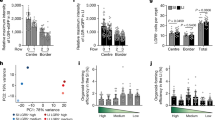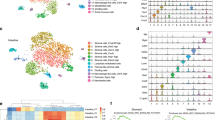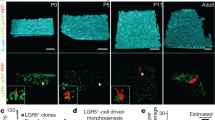Abstract
The intestinal epithelium is the most rapidly self-renewing tissue in adult mammals. It is currently believed that four to six crypt stem cells reside at the +4 position immediately above the Paneth cells in the small intestine; colon stem cells remain undefined. Lgr5 (leucine-rich-repeat-containing G-protein-coupled receptor 5, also known as Gpr49) was selected from a panel of intestinal Wnt target genes for its restricted crypt expression. Here, using two knock-in alleles, we reveal exclusive expression of Lgr5 in cycling columnar cells at the crypt base. In addition, Lgr5 was expressed in rare cells in several other tissues. Using an inducible Cre knock-in allele and the Rosa26-lacZ reporter strain, lineage-tracing experiments were performed in adult mice. The Lgr5-positive crypt base columnar cell generated all epithelial lineages over a 60-day period, suggesting that it represents the stem cell of the small intestine and colon. The expression pattern of Lgr5 suggests that it marks stem cells in multiple adult tissues and cancers.
This is a preview of subscription content, access via your institution
Access options
Subscribe to this journal
Receive 51 print issues and online access
$199.00 per year
only $3.90 per issue
Buy this article
- Purchase on Springer Link
- Instant access to full article PDF
Prices may be subject to local taxes which are calculated during checkout





Similar content being viewed by others
References
Gregorieff, A. & Clevers, H. Wnt signaling in the intestinal epithelium: from endoderm to cancer. Genes Dev. 19, 877–890 (2005)
Bjerknes, M. & Cheng, H. Clonal analysis of mouse intestinal epithelial progenitors. Gastroenterology 116, 7–14 (1999)
Winton, D. J. & Ponder, B. A. Stem-cell organization in mouse small intestine. Proc. Biol. Sci. 241, 13–18 (1990)
Potten, C. S., Booth, C. & Pritchard, D. M. The intestinal epithelial stem cell: the mucosal governor. Int. J. Exp. Pathol. 78, 219–243 (1997)
Korinek, V. et al. Depletion of epithelial stem-cell compartments in the small intestine of mice lacking Tcf-4. Nature Genet. 19, 379–383 (1998)
van de Wetering, M. et al. The β-catenin/TCF-4 complex imposes a crypt progenitor phenotype on colorectal cancer cells. Cell 111, 241–250 (2002)
Van der Flier, L. G. et al. The intestinal Wnt/TCF signature. Gastroenterology 132, 628–632 (2007)
Hsu, S. Y., Liang, S. G. & Hsueh, A. J. Characterization of two LGR genes homologous to gonadotropin and thyrotropin receptors with extracellular leucine-rich repeats and a G protein-coupled, seven-transmembrane region. Mol. Endocrinol. 12, 1830–1845 (1998)
McClanahan, T. et al. Identification of overexpression of orphan G protein-coupled receptor GPR49 in human colon and ovarian primary tumors. Cancer Biol. Ther. 5, 419–426 (2006)
Yamamoto, Y. et al. Overexpression of orphan G-protein-coupled receptor, Gpr49, in human hepatocellular carcinomas with β-catenin mutations. Hepatology 37, 528–533 (2003)
Morita, H. et al. Neonatal lethality of LGR5 null mice is associated with ankyloglossia and gastrointestinal distension. Mol. Cell. Biol. 24, 9736–9743 (2004)
Reya, T. & Clevers, H. Wnt signalling in stem cells and cancer. Nature 434, 843–850 (2005)
Cheng, H. & Leblond, C. P. Origin, differentiation and renewal of the four main epithelial cell types in the mouse small intestine. V. Unitarian Theory of the origin of the four epithelial cell types. Am. J. Anat. 141, 537–561 (1974)
Bjerknes, M. & Cheng, H. The stem-cell zone of the small intestinal epithelium. III. Evidence from columnar, enteroendocrine, and mucous cells in the adult mouse. Am. J. Anat. 160, 77–91 (1981)
Stappenbeck, T. S., Mills, J. C. & Gordon, J. I. Molecular features of adult mouse small intestinal epithelial progenitors. Proc. Natl Acad. Sci. USA 100, 1004–1009 (2003)
Soriano, P. Generalized lacZ expression with the ROSA26 Cre reporter strain. Nature Genet. 21, 70–71 (1999)
Potten, C. S., Owen, G. & Booth, D. Intestinal stem cells protect their genome by selective segregation of template DNA strands. J. Cell Sci. 115, 2381–2388 (2002)
Ohlstein, B., Kai, T., Decotto, E. & Spradling, A. The stem cell niche: theme and variations. Curr. Opin. Cell Biol. 16, 693–699 (2004)
Clayton, E. et al. A single type of progenitor cell maintains normal epidermis. Nature 446, 185–189 (2007)
Nishimura, S., Wakabayashi, N., Toyoda, K., Kashima, K. & Mitsufuji, S. Expression of Musashi-1 in human normal colon crypt cells: a possible stem cell marker of human colon epithelium. Dig. Dis. Sci. 48, 1523–1529 (2003)
Potten, C. S. et al. Identification of a putative intestinal stem cell and early lineage marker; musashi-1. Differentiation 71, 28–41 (2003)
O’Brien, C. A., Pollett, A., Gallinger, S. & Dick, J. E. A human colon cancer cell capable of initiating tumour growth in immunodeficient mice. Nature 445, 106–110 (2007)
He, X. C. et al. BMP signaling inhibits intestinal stem cell self-renewal through suppression of Wnt–β-catenin signaling. Nature Genet. 36, 1117–1121 (2004)
Morris, R. J. et al. Capturing and profiling adult hair follicle stem cells. Nature Biotechnol. 22, 411–417 (2004)
Bjerknes, M. & Cheng, H. Multipotential stem cells in adult mouse gastric epithelium. Am. J. Physiol. Gastrointest. Liver Physiol. 283, G767–G777 (2002)
Sleeman, K. E. et al. Dissociation of estrogen receptor expression and in vivo stem cell activity in the mammary gland. J. Cell Biol. 176, 19–26 (2007)
Muncan, V. et al. Rapid loss of intestinal crypts upon conditional deletion of the Wnt/Tcf-4 target gene c-Myc. Mol. Cell. Biol. 26, 8418–8426 (2006)
Peters, P. J., Bos, E. & Griekspoor, A. in Current Protocols in Cell Biology 4.7.1–4.7.9 (Wiley, New York, 2006)
Ramírez-Solis, R. et al. Genomic DNA microextraction: a method to screen numerous samples. Anal. Biochem. 201, 331–335 (1992)
Lakso, M. et al. Efficient in vivo manipulation of mouse genomic sequences at the zygote stage. Proc. Natl Acad. Sci. USA 93, 5860–5865 (1996)
Acknowledgements
We thank R. Vries for preparing total RNA from isolated intestinal crypt and villus fractions and S. van den Brink for help with the embryonic stem cell work. We would like to acknowledge financial support from the following sources: Genmab B.V., Koninklijke Nederlandse Akademie van Wetenschappen (KNAW), Koningin Wilhelmina Fonds (KWF), Maag Lever en Darm Stichting (MLDS), European Molecular Biology Organization (EMBO), SenterNovem BSIK, Louis Jeantet Foundation and the European Union.
Author information
Authors and Affiliations
Corresponding author
Ethics declarations
Competing interests
H. Clevers is an inventor on several patents involving Wnt target genes, as is N. Barker.
Supplementary information
Supplementary Figures
The file contains Supplementary Figures 1-4 with Legends. In Supplementary Figure 1 it is shown that GFP-positive CBC cells in the small intestine of LGR5-Ires-CreERT2 knock-in mice are frequently Ki67 positive, confirming that they are typically cycling cells. The general strategy used to generate the LGR5-Ires-CreERT2 knock-in mice is outlined in Supplementary Figure 2. In Supplementary Figure 3 it is demonstrated that CBC cells and +4 cells differ in their relative sensitivity to radiation-induced apoptosis, confirming that they are distinct cell types. Lgr5-positive CBC cells permanantly marked by the genetic activation of a lacZ reporter gene generate a stream of blue progeny migrating from the crypts onto the villi. This phenomenon is readily visible as blue ribbons on the whole mount pictures in Supplementary Figure 4. (PDF 2162 kb)
Supplementary Video
The file contains Supplementary Video 1. This movie shows a confocal 3D reconstruction of an Lgr5 GFP-positive crypt (inverted). Approximately six GFP-positive CBC cells are visible as wedge-shaped cells located at the base of the crypt. Nuclei are counterstained in red. (MOV 1419 kb)
Rights and permissions
About this article
Cite this article
Barker, N., van Es, J., Kuipers, J. et al. Identification of stem cells in small intestine and colon by marker gene Lgr5. Nature 449, 1003–1007 (2007). https://doi.org/10.1038/nature06196
Received:
Accepted:
Published:
Issue Date:
DOI: https://doi.org/10.1038/nature06196
This article is cited by
-
A novel avian intestinal epithelial cell line: its characterization and exploration as an in vitro infection culture model for Eimeria species
Parasites & Vectors (2024)
-
Probiotic Pediococcus pentosaceus restored gossypol-induced intestinal barrier injury by increasing propionate content in Nile tilapia
Journal of Animal Science and Biotechnology (2024)
-
Crosstalk between colorectal CSCs and immune cells in tumorigenesis, and strategies for targeting colorectal CSCs
Experimental Hematology & Oncology (2024)
-
Targeted activation of ferroptosis in colorectal cancer via LGR4 targeting overcomes acquired drug resistance
Nature Cancer (2024)
-
Claudin-7 is essential for the maintenance of colonic stem cell homoeostasis via the modulation of Wnt/Notch signalling
Cell Death & Disease (2024)
Comments
By submitting a comment you agree to abide by our Terms and Community Guidelines. If you find something abusive or that does not comply with our terms or guidelines please flag it as inappropriate.



